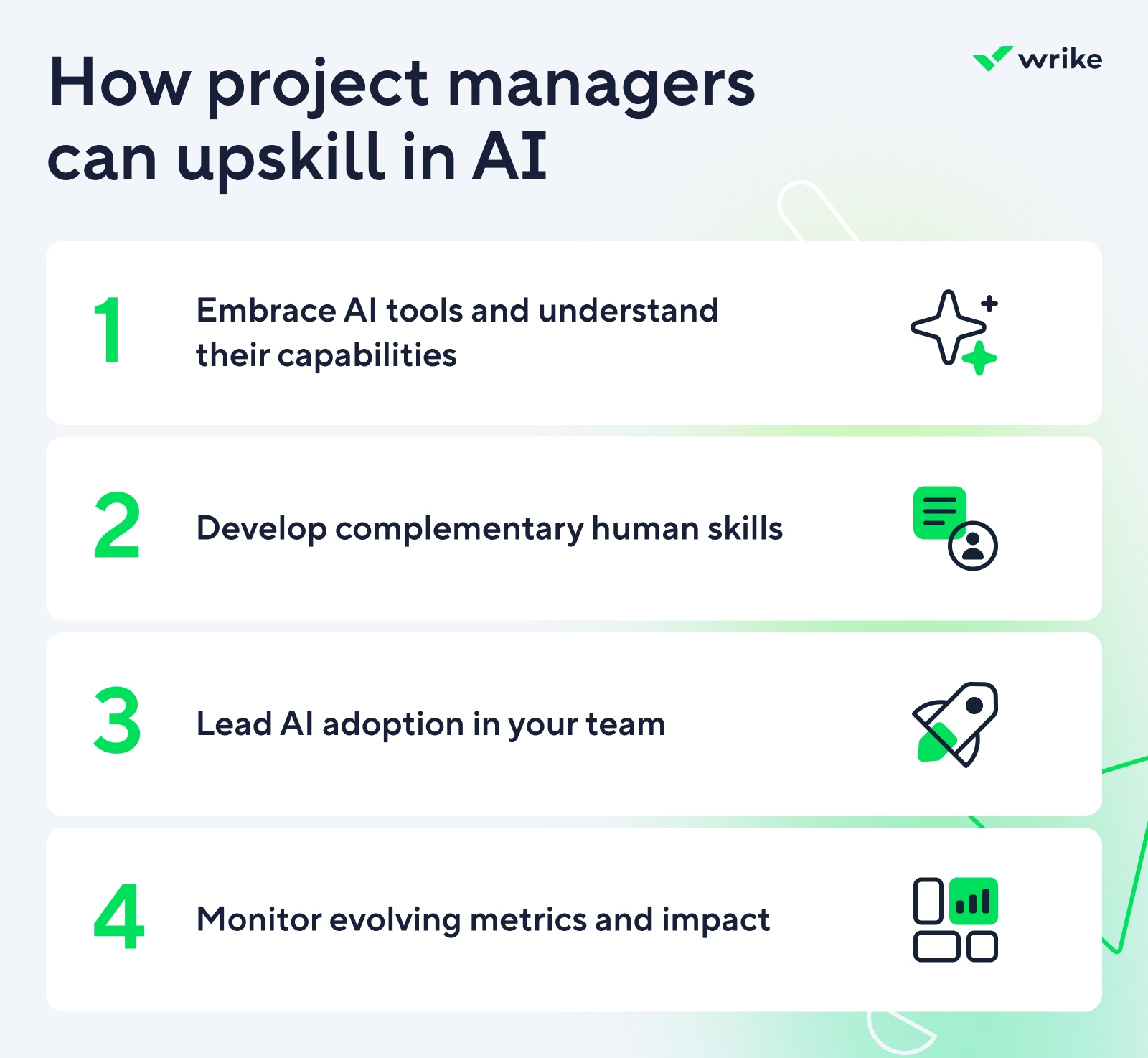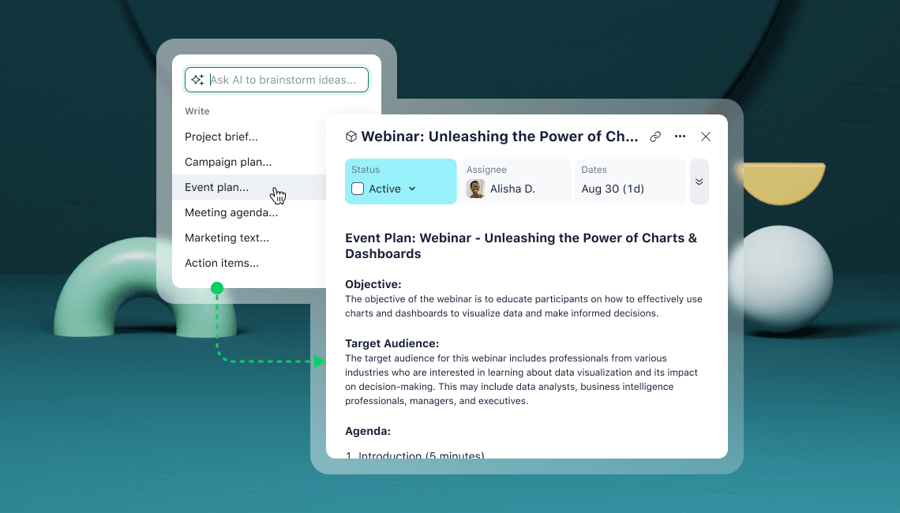Key takeaways:
- Will AI replace project managers? No, AI will automate administrative tasks while PMs will focus on leadership, strategy, and complex decision making.
- Which PM roles are most at risk? Entry-level project coordinators and PMO support roles are most exposed to automation.
- What skills are necessary for PMs in the AI era? PMs need enhanced leadership, stakeholder management, and AI fluency to remain relevant.
- How can junior PMs future-proof their careers? Junior PMs should learn AI tools early, focus on stakeholder communication, and engage in change initiatives.
- How can you get started with AI in project management? Identify specific pain points and test AI features in those areas to improve efficiency.
“Will AI take my job?” used to be a line out of a Black Mirror episode. Now, it’s a topic in team meetings, LinkedIn posts, and every second think piece in your feed. And if you’re a project manager, you’re right in the middle of it. Tools can already summarize meetings, build timelines, and ping people who are behind on tasks. So it’s fair to ask: if it can do all that, will project management be replaced by AI?
Some voices argue that project management is on borrowed time, while others contend that PMs are safer than most roles because so much of the job involves people: alignment, negotiation, navigating politics, and making judgment calls.
The reality is more complicated than either extreme. AI is already reshaping how work gets planned, tracked, and delivered. But the question isn’t just “Can project managers be replaced by AI?” It’s “What do we actually trust it to own?” and “Where do humans still create the most value?”
How AI is changing the project manager role
Much of the classic PM workload is precisely what AI excels at: updating timelines, tracking dependencies, retrieving information from various tools, formatting reports, and reminding people (again) that their task is overdue.
As more of that gets automated, the real question becomes: what do you do with the time you get back? The PMs who are leaning into AI aren’t doing less. They’re doing different work:
- Spending more time with stakeholders to clarify priorities before projects even start
- Facilitating tougher conversations about trade-offs, risk tolerance, and scope
- Working across teams to remove systemic blockers instead of micromanaging task lists
AI provides the operational lift, but the strategic and human elements still land on your desk.
That’s where a new skill set comes in:
- AI literacy: You need a working understanding of what AI can and can’t do and how it fits into your tools. Not a data scientist, but not “I’ve heard of ChatGPT” either.
- Prompting skills: Design prompts and input patterns so AI tools work the way you need. Turn fuzzy requests into clear instructions the system can follow.
- Data literacy: Reading dashboards is not enough. You must question metrics, identify junk data, and understand how flawed inputs can lead to poor “smart” decisions.
- Critical thinking: AI will confidently give you nonsense. Be able to challenge outputs and say, “We’re not doing that.”
- Stakeholder management: Someone has to explain AI-driven forecasts, negotiate trade-offs, and calm people down when the tool surfaces uncomfortable truths. That’s you.
- Change leadership: AI changes workflows, roles, and comfort zones. PMs who can guide teams through that shift are valuable; the ones who just “roll out a tool” are replaceable.
- Communication: Turning complex, AI-generated insights into clear actions and decisions is the difference between interesting and useful.
- Domain expertise: Without context, you can’t judge whether an AI recommendation makes sense in your actual business.
We’re already seeing this shift play out. In recent industry surveys, a growing share of project managers say they’re using AI for reporting, scheduling, and risk analysis, while their own time is shifting toward strategic alignment.
How AI’s impact differs across fields
Project management isn’t one-size-fits-all, and AI isn’t either. The tools might look similar on the surface, but how they actually change the job depends heavily on where you work and what you’re delivering.
Technology and software development
In tech and software, AI is practically baked into the workflow already. Teams are using it to automate backlog grooming, estimate story points, flag risky dependencies, and forecast sprint capacity without a PM living inside a spreadsheet all week. Tools can track velocity trends and highlight which epics are quietly ballooning before anyone notices.
That shifts the center of gravity for PMs. Instead of spending energy on manual task tracking, they’re pulled closer to product strategy:
- Translating business goals into coherent roadmaps
- Negotiating scope and trade-offs with stakeholders
- Making calls on what not to ship, even when the model says it’s “possible”
The mechanics of the sprint are increasingly handled by the system. The value comes from reading the signals and turning them into decisions that teams actually believe in.
Marketing and creative operations
Marketing workflows and creative work are getting hit by AI from every angle: generative content, automated campaign optimization, real-time sentiment tracking, and creative variations spun up in seconds. Tools can draft copy, resize assets, test headlines, and feed performance data back into the brief.
For project managers in these teams, the job is less “chasing designers for the banner” and more “orchestrating the entire creative flow.” That includes:
- Aligning stakeholders on the campaign narrative before assets are created
- Coordinating rapid test-and-learn cycles across channels
- Weaving campaign analytics back into planning so the next brief is smarter than the last
- Tightening approval loops so fast iterations don’t get stuck in review purgatory
And this isn’t theoretical. Recent surveys show around 88% of marketers now use AI in their day-to-day roles, and 77% classify their understanding of AI as intermediate or advanced, which means PMs in marketing are effectively managing hybrid human/AI workflows.
Construction and engineering
Construction and engineering live in a very different reality: physical sites, safety regulations, weather, permits, supply chains. Here, AI shows up as predictive scheduling, risk modeling, and cost forecasting, trying to tame all that complexity.
Recent research on AI-driven cost estimation reports accuracy levels in the 80–90% range for advanced machine learning and deep learning models, outperforming many traditional estimation methods and helping teams anticipate overruns earlier.
Other research shows that AI in construction management has significant potential to boost productivity, lower costs, and improve overall project outcomes.
Adoption is no longer niche. A 2025 survey of project professionals found that about 75% of those working in construction say their organization now uses AI in projects, up from just 15% two years earlier.
Many of them see the biggest gains in resource allocation, risk assessment, and schedule automation. AI improves the visibility and reliability of the data, but it doesn’t pour concrete, walk the site, or manage safety culture.
So PMs in this world lean into:
- Coordinating between office and field teams
- Interpreting model outputs in the context of real-world constraints
- Making judgment calls when the forecast says “go” but the site clearly isn’t ready
AI in construction project management sharpens the plan. Humans still own execution and safety.
AI impact across other fields
Outside these examples, you see the same pattern play out with different flavors:
- In healthcare, AI helps with scheduling, capacity planning, and triage prediction, while project leaders focus on governance, compliance, and change management so clinical teams can trust the system.
- In finance, AI accelerates risk modeling, fraud detection, and scenario planning, leaving PMs to navigate regulation, stakeholder expectations, and cross-functional delivery.
- In the public sector and nonprofits, AI can streamline case management and resource allocation, but adoption is slower and more sensitive, so PMs spend more time on ethics, policy alignment, and stakeholder communication.
Same technology, very different realities. That’s why asking “Will AI replace project managers?” without asking “In which field?” misses half the story.
Roles most affected (and why)
Not every project manager is staring down the same level of disruption. The closer your day-to-day is to “collect, update, forward, repeat,” the more exposed you are. Roles that lean heavily on administrative tasks and data wrangling are squarely in AI’s strike zone.
1. Entry-level/tactical project coordinators
This is where the impact shows up first. Entry-level project coordinators often spend most of their time on highly structured, repetitive work:
- Chasing status updates
- Scheduling meetings
- Assigning resources based on fixed rules
- Updating dashboards and task boards
- Consolidating notes into summaries
These are exactly the kinds of tasks agentic and generative AI are already good at. That doesn’t mean every coordinator role disappears overnight, but it does mean the “busywork” version of the job has a short shelf life.
The coordinators who stick around will be the ones stepping up into clearer ownership by managing stakeholder expectations and shaping how AI is used for project management instead of just feeding it data.
2. PMO support roles/reporting and governance roles
If your role lives inside spreadsheets and slide decks, AI is already knocking on the door. Harvard Business Review has already flagged planning, reporting, and project monitoring as some of the PM tasks most likely to be transformed by AI.
Many PMO support roles are built around:
- Collecting and standardizing project data
- Producing portfolio-level status reports
- Tracking KPIs and compliance
- Enforcing governance processes
That’s exactly where tools like Wrike’s Work Intelligence® can scan project activity and historical data to predict which projects are likely to slip, and help PMOs monitor entire portfolios without manually stitching data together.
So what happens to the PMO role? It tilts away from producing reports and policing processes toward:
- Interpreting AI-driven insights for executives
- Designing governance models that work with automation, not against it
- Deciding which risks actually matter, instead of just listing them
The raw reporting work shrinks. The strategic oversight and advisory side grows.
3. PMs in high-volume, low-complexity projects
There’s also a whole class of project work that is incredibly tempting for AI to absorb: high-volume, low-complexity, highly repeatable projects.
Things like:
- Routine IT rollout or upgrade projects
- Standardized small marketing campaigns
- Repeated regulatory or policy implementation projects
- Template-driven client onboarding or internal process rollouts
These projects tend to follow well-known playbooks with predictable phases, dependencies, and risks. Once that pattern is captured in data and templates, AI tools can take the wheel.
If the human PM in these environments is mostly running the play instead of shaping it, AI can eat a significant portion of the execution layer. The role doesn’t always vanish, but it can shrink, stretch across more projects, or morph into an oversight position where one person supervises an AI-supported portfolio instead of manually driving each individual project.
The pattern across all three roles is the same: the more your value is tied to collecting, formatting, and pushing data around, the more exposed you are. The more your value is tied to judgment and navigating messy realities, the harder you are to replace.
Roles relatively safe (for now) and why
Some roles sit much closer to the “human leadership, strategy, and complexity” end of the spectrum. Those are harder for AI to fully swallow. Automation can support them, or even reshape them, but outright replacement is a stretch.
1. Strategic project managers
Strategic PMs already live above the task level. Their work leans heavily on judgment and trust. They’re mediating between execs, product, finance, operations, and everyone who thinks their priority is the priority.
Research on the future of project management backs this up. PMI’s “Shaping the Future of Project Management with AI” report stresses that PMs who stay relevant will be those who move toward strategic leadership and actively drive AI adoption.
It also points out that only around 20% of project managers currently report strong practical experience with AI, while nearly half have little to none, which makes AI fluency a clear differentiator for strategic roles.
So, safe here doesn’t mean untouched. It means:
- Combining strategic thinking with fluency in AI capabilities and limits
- Using AI outputs to inform decisions, not replace them
- Explaining what the data means and what to do about it
In other words, strategic PMs are less at risk if they upgrade their skills instead of coasting.
2. High-complexity, creative, or change-led project leaders
This kind of work is structured chaos. AI can support it, but it can’t own it. AI can help with planning scenarios and risk signals, but it doesn’t sit in the room when two executives quietly disagree about what “success” actually means.
These projects are full of:
- Ambiguous goals that evolve as you learn
- Large, misaligned stakeholder groups
- Political trade-offs and conflicting incentives
- Deep organizational habits that don’t change just because a slide says so
Change-led and creative projects still rely heavily on:
- Sense-making in uncertain, shifting environments
- Reading the room and adjusting the approach
- Aligning different groups behind a shared story
- Coaching leaders and teams through discomfort and resistance
3. Hybrid roles (human + AI)
The most realistic future for many PMs is hybrid: not “PM versus AI,” but “PM plus AI.” The hybrid PM focuses on:
- Validating and challenging the data
- Deciding which risks and opportunities to act on
- Translating insights into decisions and actions
- Managing the human side of change
Again, PMI’s report leans hard into upskilling. It frames AI as something PMs need to understand, shape, and lead.
For these hybrid roles, the safety net comes from three things:
- Understanding AI: How it works, where it fails, and how to question it
- Owning data governance: Knowing which inputs matter, how they’re captured, and how trustworthy they are
- Working in adaptive ways: More experimentation, shorter feedback loops, and less attachment to rigid plans
Those who lean into this “human + AI” model become the people everyone else looks to when the organization is trying to figure out how to work in this new reality.
What project managers can do to stay relevant
AI is already changing how projects run, so the safest place to be is the person who knows how to use it and steer it.
1. Embrace AI tools and understand their capabilities
Step one is simple: stop treating AI as a vague concept and start treating it as part of your toolbox. Start with AI project management tools closest to your daily work:
- Task and project automation inside your work management platform
- Assistants that can summarize meetings, write follow-ups, and draft status updates
- Forecasting and risk features that flag likely delays or overloads
Pick one or two workflows you repeat every week and experiment with how AI can speed them up. And remember, choosing the best AI project management tools will be dependent on your team.
2. Develop complementary human skills
As AI takes over more of the mechanical work, the human edge moves further into judgment and problem solving.
That looks like:
- Leadership: Setting direction, making decisions when the data is incomplete, and keeping people focused when things get messy
- Stakeholder management: Aligning executives, customers, and teams who don’t all want the same thing
- Judgment: Knowing when to trust the model, when to override it, and when to ask better questions
- Complex problem solving: Working through cross-functional, multi-constraint problems that don’t fit into a simple template
These are the skills that make AI more useful and hardest to automate.
3. Lead AI adoption in your team
If AI is coming into your workflow anyway, you’re better off being the person driving that change than the person reacting to it. Project managers are in a strong position to:
- Identify repetitive, error-prone processes that are ripe for automation
- Evaluate tools through both a technical and a “will people actually use this?” lens
- Design how AI fits into existing workflows so it supports, not disrupts, collaboration
- Set guardrails for quality, approvals, and data privacy
Treat AI adoption like any other change initiative. Set clear goals, defined success criteria, training, communication, and feedback loops. You’re not just a user here; you can be the one shaping how AI is embedded into the way your team works.
4. Monitor evolving metrics and impact
If you’re going to use AI in project management, you should also be measuring whether it’s helping. Consider setting up KPIs that track both productivity and quality, such as:
- Throughput: Tasks completed or projects delivered per period
- Cycle time: How long key workflows (approvals, handoffs, reviews) actually take
- Risk indicators: Number of issues caught early vs. late, variance from forecast
- Stakeholder satisfaction: Feedback from sponsors, customers, and team members
Compare before and after where you can, and treat AI like any other investment. It should be improving responsiveness, visibility, and outcomes.
So, will AI replace project managers?
In most cases, AI won’t replace project managers, but it will replace the administrative aspect of the role. The more your work leans on leadership, judgment, strategy, and change making, the more AI becomes an amplifier, not a substitute.
The risk isn’t that PMs disappear, it’s that the gap widens between PMs who work with AI and those who ignore it.
If you want to firmly establish yourself in the first group, this is the moment to start experimenting. Wrike AI agents can take on the repetitive monitoring, nudging, and updating, so you can focus on the decisions that actually move projects forward.
Try them on a project and see what your role looks like when the work around you is just a little bit smarter and a lot more automated.
FAQ
Which project management roles are most at risk from AI?
Roles that focus heavily on status tracking and routine coordination are most exposed. Entry-level project coordinators, PMO reporting roles, and PMs running high-volume, low-complexity projects will see more of their day-to-day work automated.
What skills will project managers need in the age of AI?
Project managers will need stronger skills in leadership, stakeholder management, change management, and complex problem solving, plus “AI fluency,” which is understanding what AI tools can do and how to use them responsibly in real projects.
Do project managers need to learn to code to use AI effectively?
No. Most AI capabilities are delivered through tools and platforms, not raw code. What matters more is the ability to define the right questions, understand data inputs and outputs, and build workflows that leverage the strengths of both humans and AI.
How can junior project managers future-proof their careers?
Junior PMs and coordinators can stay relevant by moving beyond pure admin work: learning AI tools early, taking on more stakeholder communication, practicing decision making, and getting involved in change and improvement initiatives.
How do I get started with AI in my project workflow?
Choose one or two pain points, such as risk tracking or routine follow-ups, and test AI features there first. See where AI saves the most time and where you still need a human decision. Then, expand from there.






